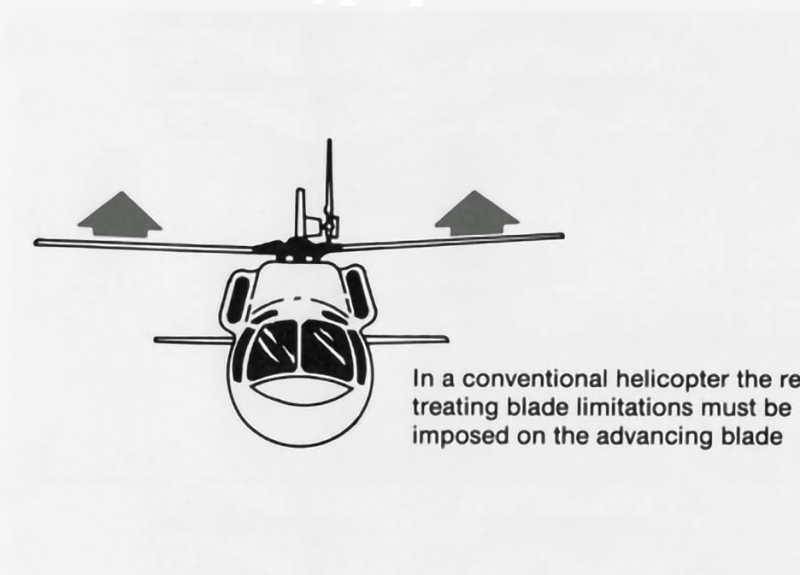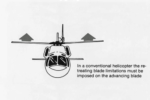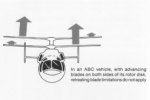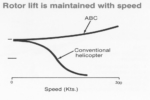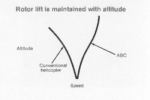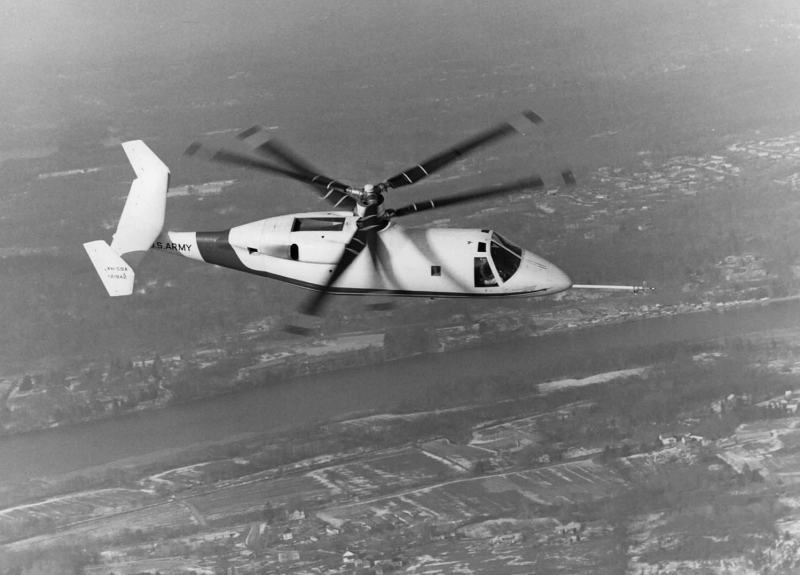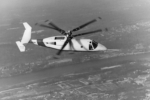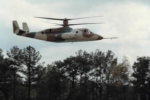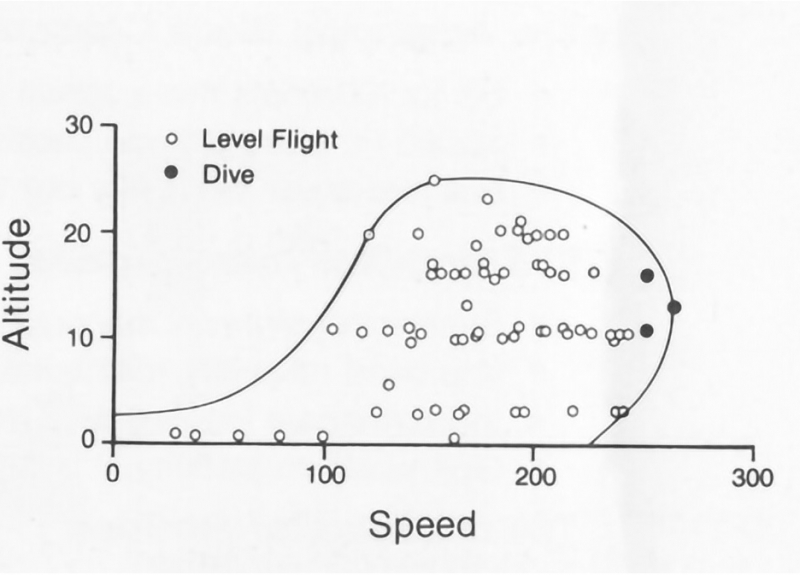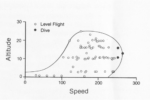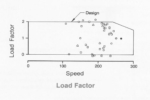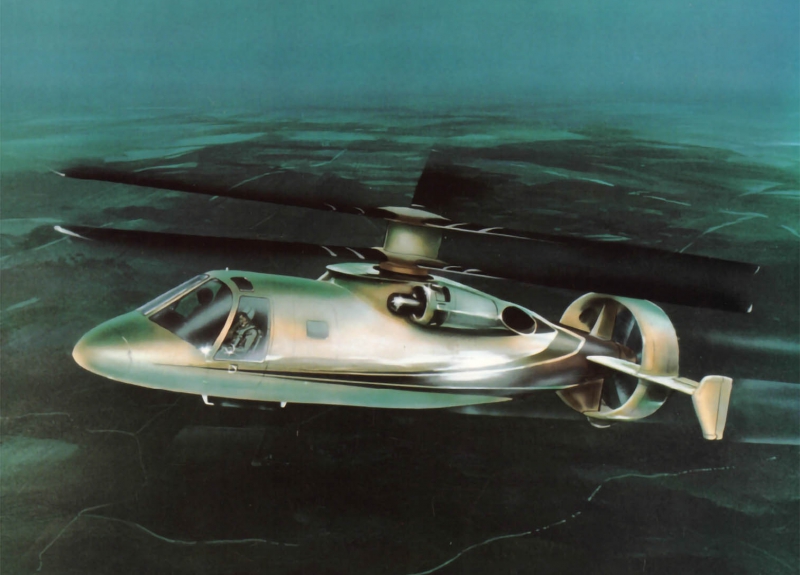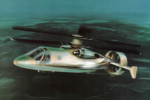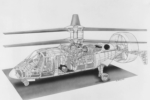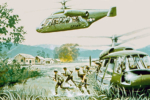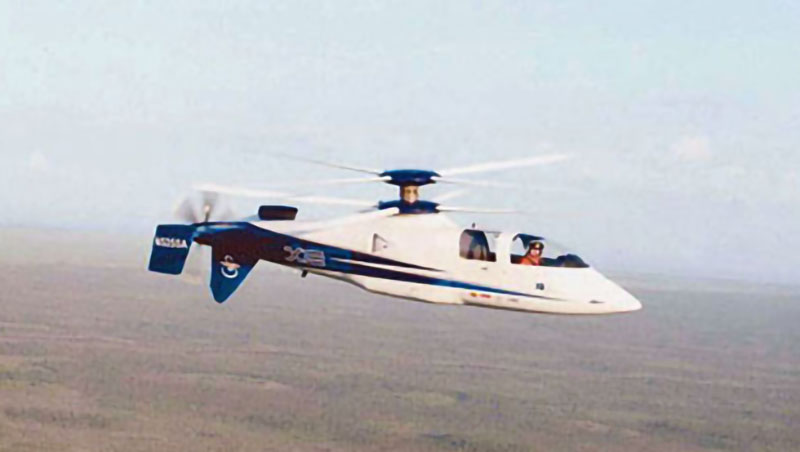Sikorsky Product History
Sikorsky S-69
Background
In the mid-1960s many companies in the helicopter industry were investigating technologies to expand the speed envelope of the helicopter. Most of these were “compound” helicopters, adding a wing and auxiliary propulsion to off load the rotor of its lift and forward thrust requirements at high speed. Sikorsky was experimenting with a compound helicopter, the S-61F/NH-3, using an S-61/H-3 airframe. But Sikorsky also created an alternative to the compound helicopter – the Advancing Blade Concept, or ABC. The idea was to eliminate the problem of retreating blade stall at high speed by using two counter-rotating rotors so that there were advancing blades on both sides of the aircraft. Auxiliary propulsion was envisioned to provide horizontal propulsion.
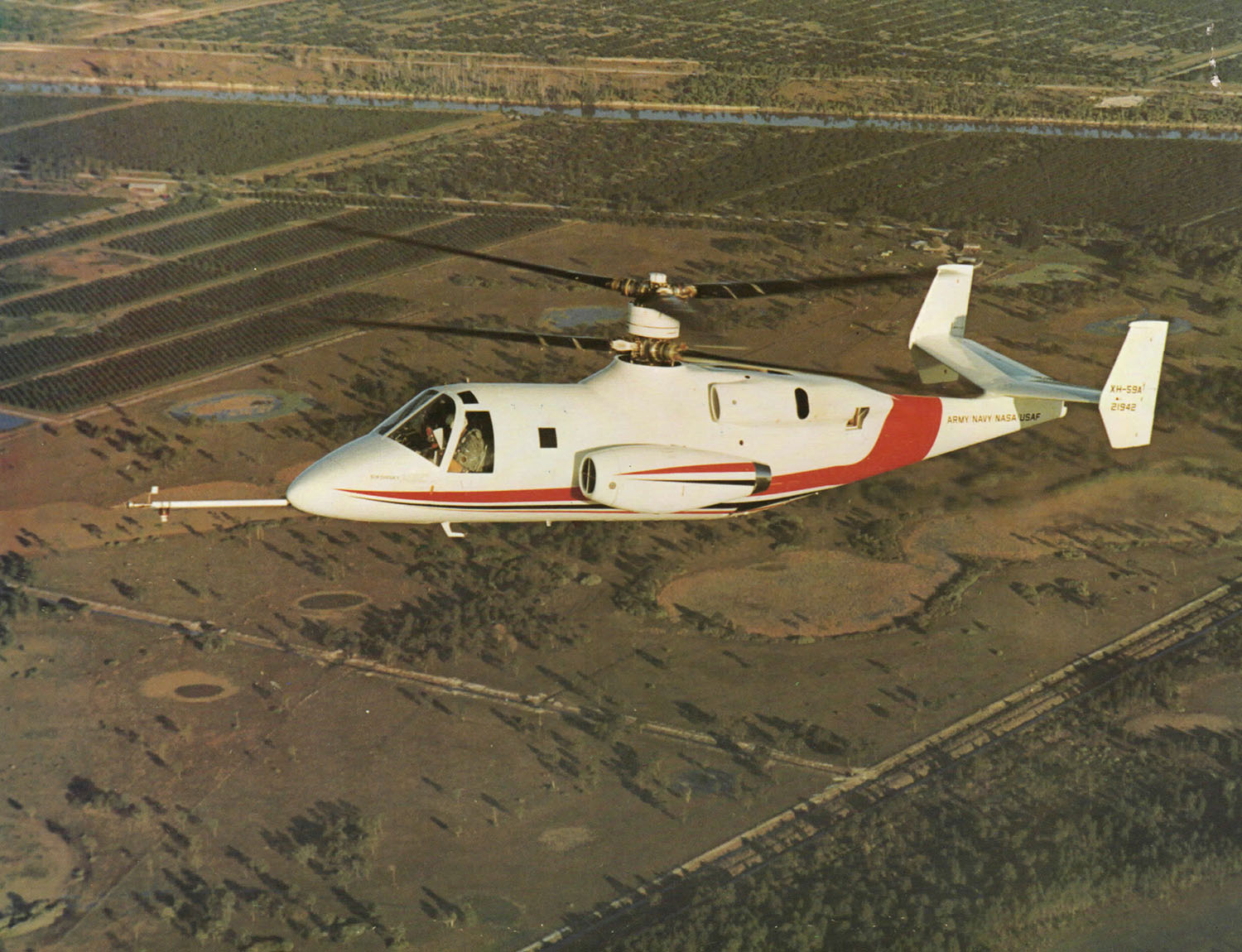
There were many coaxial helicopter developments during and after World War II. By the 1960s the Russians had a coaxial helicopter in production. But all of these were two conventional rotors mounted in a coaxial counter-rotational configuration. Primarily the advantages were compactness and the elimination of the tail rotor; no thought or capability of using “advancing blade” lift was considered in these designs.
The advancing blade concept had been shown in a textbook in the 1930s, but the structural requirements for the blades were well beyond the technology of the day. There could be no flapping hinges; the rotors would have to be very stiff so that the rotor’s center of lift could migrate off the rotor centerline. The rotor design had to be more similar to that of a propeller than that of then current helicopter rotors.
With this rotor configuration, the rotor’s capability to generate lift would not drop off with speed, or with altitude. This was a major breakthrough in helicopter technology.
By the 1960s Sikorsky believed that technology had progressed to the point that a practical application of the concept was possible. Sikorsky stated working on the concept in 1964. Designs were prepared for the rotor, drive system, and controls, and preliminary designs of mission aircraft were studied. At this time, the effort was on developing the concept with no specific mission identified.
It became apparent that the biggest challenge was going to be the construction of the rotor blades. Sikorsky’s production rotor blades at that time had spars made from constant-section extruded aluminum. ABC required the spar to be tapered in both diameter and wall thickness to be able to carry the high bending moments developed when the rotor’s lift moved off the rotor centerline. It also required titanium rather than aluminum to get the strength and modulus necessary for a practical blade design. After a number of false starts over the next four years, a manufacturing method was developed that used a 17 foot 6AL-4V titanium extrusion which was machined both inside and out to produce tapered diameter and wall thickness. The spar tubes were then hot formed into an elliptical shape, while twisted, in ceramic hot-forming dies. This proved to be successful, although it was a complex and expensive process which would have been prohibitive if the ABC were to be competitive for a production design.
A 40 ft. diameter test rotor was fabricated in 1970 and tested in the NASA Ames 40 x 80 ft. wind tunnel. This proved the basic advancing blade concept and led to a contract in 1972 with the U.S. Army for the design, fabrication, and flight testing of the XH-59A advancing blade concept demonstrator aircraft. Two aircraft were fabricated.
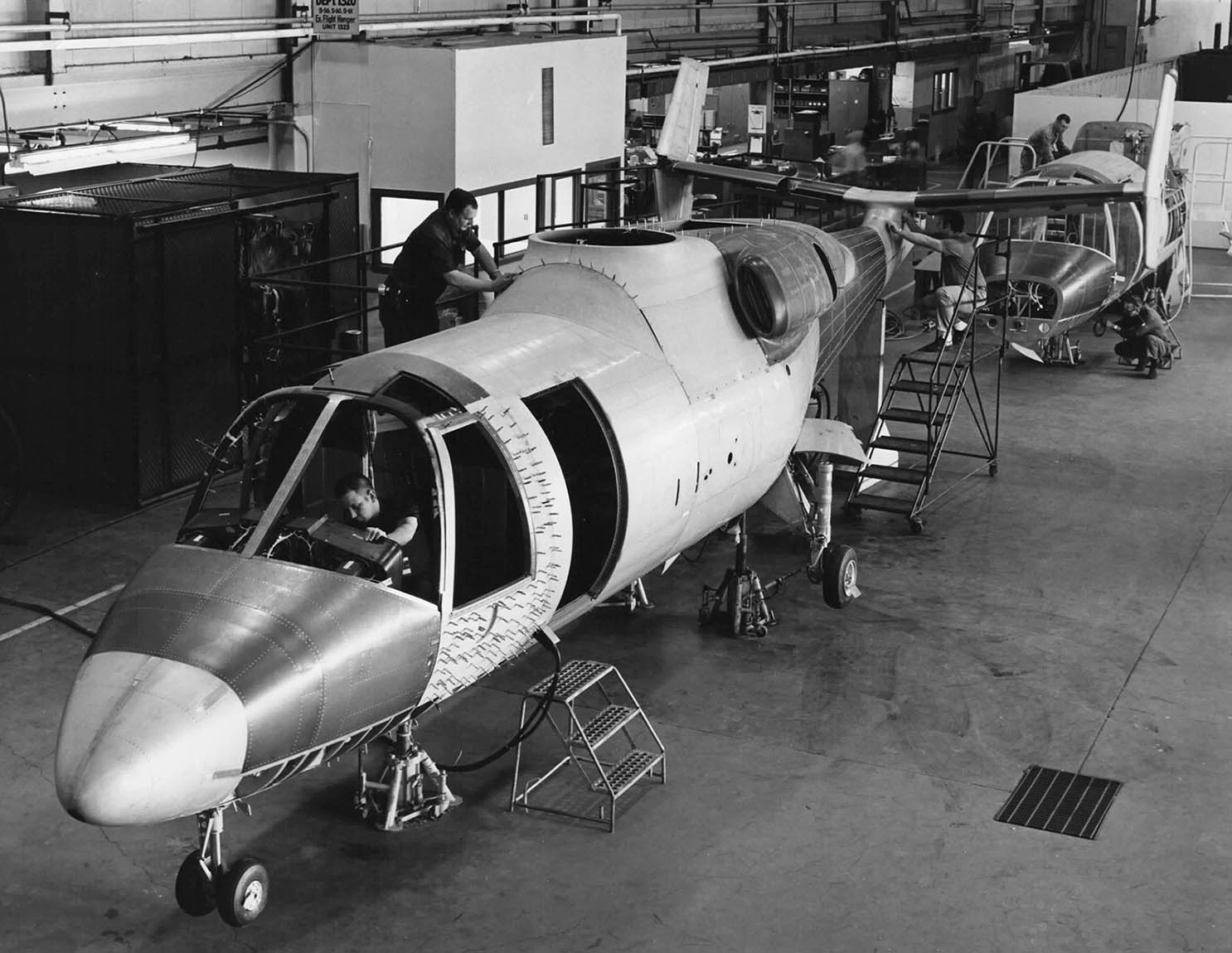
First flight occurred in June, 1973. One month later the first XH-59A aircraft experienced a low speed accident on the flight field. The design team had never dealt with a rotor system as stiff as this before. There was much concern about the extremely high control power that the rotor could develop. As a result, the control system was designed with a very low gain to prevent the controls from being too sensitive. This seemed to work out fine in the initial hover tests. However, when the pilots moved out of hover to transition to forward flight, the aircraft tended to nose up. The pilot inputted more and more forward cyclic to counter this, until the stick was on the forward stop and the aircraft was still nosing up. The pilot reduced the collective to get it back on the ground. The tail contacted the ground first and the aircraft rolled over until the blades struck the ground. The rotor system was destroyed. Both pilots were uninjured.
This set the program back for over a year while the cause of the accident was determined. The conclusion was that the control system gains were too low to cover all flight modes. Aircraft #1 was rebuilt for wind tunnel testing, but was not returned to flight status
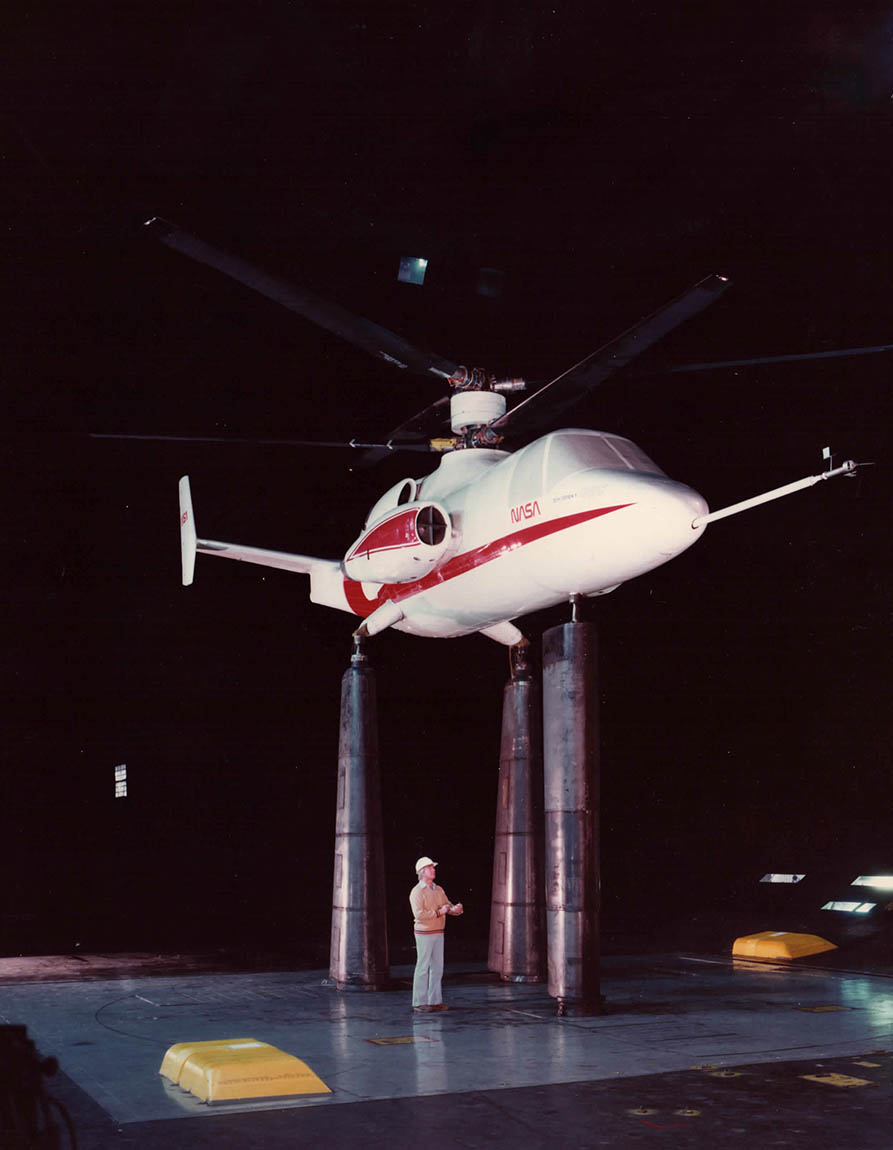
Flight testing with the second aircraft resumed in November, 1974. An extensive flight test program of about 170 flight hours was accomplished through 1981. During this period the Navy, Air Force, and NASA joined the Army in providing funding support. From July 1975 to March 1977 the helicopter configuration was tested. The test envelope was expanded to level flight at 156 knots, dive speeds to 186 knots, and altitudes to 14,000 feet. Auxiliary propulsion flights were conducted from April 1978 to January 1981. The aircraft accomplished virtually all of its technical objectives. A maximum level flight speed of 240 knots was achieved, making this the first rotary wing aircraft to achieve this speed without the use of an auxiliary wing, thus proving the basic advancing blade concept. Stability and control proved to be excellent. The entire flight envelope was flown without any artificial stabilization equipment.
Configuration Features
The XH-59A was a unique design built strictly as a test vehicle for the advancing blade concept rotor system. The 40 foot diameter rotor that was wind tunnel tested in 1970 was sized for a 14,500 lb gross weight, 230 knot aircraft which was felt at the time to be a size with a wide range of mission potential. In 1972 when the XH-59A design was initiated, Sikorsky was interested in an Aerial Armored Reconnaissance Vehicle, or AARV, which was a smaller size. (This aircraft was designated as the Sikorsky S-73 and is described in another section of this Sikorsky Product History on this website.) The rotor diameter was therefore reduced to 36 ft. Blade construction was similar to that of the wind tunnel rotor. There were no hinges in the design. Pitch change was accomplished with conventional stack bearings. The blades were coned up at 3º. There was a 30 inch spacing between the two rotors.
The airframe was circular in cross section, sized for a crew of two in a side-by-side configuration, and with a small cabin for experimental test equipment. To reduce cost the drive system for the rotor and the auxiliary propulsion were not integrated. Two P&WA PT-6 engines were used to power the rotors. Two J-60 engines and their North American Saberliner pods (which were previously used on Sikorsky’s S-61F experimental compound helicopter) were used for auxiliary propulsion. The transmission used a simple compound planetary gearing arrangement to provide two counter-rotation output shafts and a high reduction ratio.
One of the concerns with the coaxial rotor arrangement was how to provide aircraft yaw control. With the counter-rotating rotors, no tail rotor was required to react rotor torque. Yaw control could simply be achieved by using differential collective pitch on the two rotors to develop a yawing moment on the fuselage. This had been used successfully on most coaxial helicopters in the past. The problem was that at low or no lift on the rotor the resulting yaw moment did not exist. Even worse, in autorotation the yaw control reversed direction. One of the unique features of the XH-59A gearbox was an ability to create differential rotor speed, which would provide yawing moments which did not reverse in autorotation. Although designed in to the gearbox, this feature was not found to be required during the development flight test program.
Yaw control was achieved by using differential collective pitch in hover. This was phased out at speeds from 40 to 80 knots and yaw control was provided by rudders. An “H” tail, with rudders, was used to get the vertical tails outboard in clean air for better effectively.
The aircraft was designed to fly with or without the auxiliary propulsion J-60s installed. As the design evolved, the aircraft weight grew to where it could not hover with the J-60s installed, so tests in the aux propulsion mode required a rolling takeoff.
General Arrangement Drawing
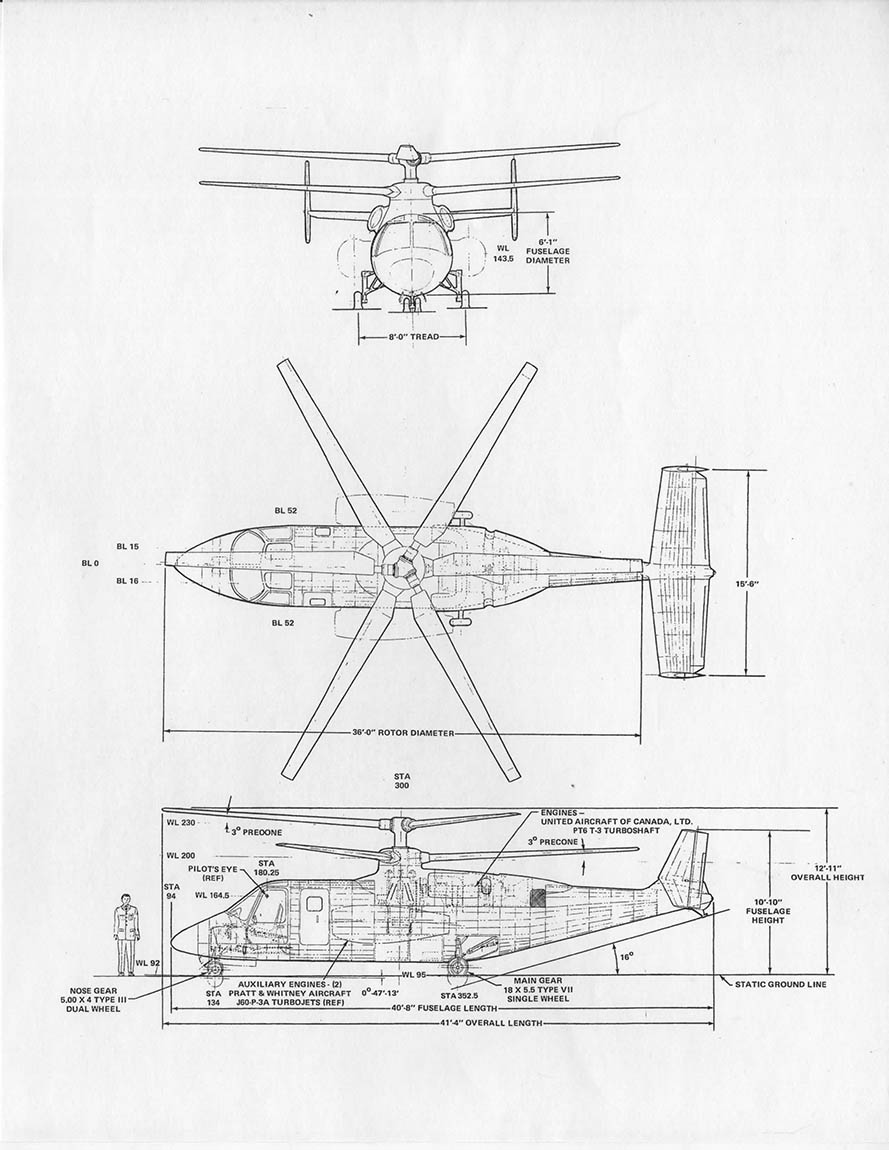
General Characteristics and Performance
| S-69 Characteristics and Performance | |
|---|---|
| Rotor Diameter | 36 ft. |
| Number of Blades per Rotor | 3 |
| Rotor Propulsion System | Pratt & Whitney PT6T-3 Twinpack |
| Maximum Continuous Power | 1,452 hp |
| Maximum Short Term Power | 1,728 hp |
| Auxiliary Propulsion | Two Pratt & Whitney J60-P-3A |
| Static Thrust, Sea Level | 3,300 lbs |
| Maximum Hovering Gross Weight | 11,800 lbs |
| Max Auxiliary Propulsion Gross Weight | 12,500 lbs |
| Max Level Flight Speed, Low Altitude | 240 knots |
| Max Dive Speed, 7º Dive | 263 knots |
| Max Altitude | 25,500 ft |
| Max Demonstrated Load Factor | 2.0 g at 225 knots |
| Min Demonstrated Load Factor | 0.0 at 235 knots |
| Max Rate of Climb | 5,000 ft/min |
| Max Acceleration | 0 to 185 kts in 28 seconds |
| Hover Noise Level | 84 PNdB at 500 ft. |
| Hover Figure of Merit | 0.8 |
The XH-59A exhibited excellent handling qualities. The rigid rotors provided high control power. With these rigid rotors, the lack of a tail rotor, and the use of a separate auxiliary propulsion system, the controls were almost perfectly orthogonal. Each control input provided the desired control response with little extraneous response in the other axes.
The U.S. Army capped its formal participation in the program in May 1981 with an operational evaluation of the aircraft at Ft. Rucker, Alabama. The abstract of the Army final report summarizes these conclusions:
“NOE [nap of the earth] flight handling qualities revealed the XH-59A is capable of the intricate, demanding maneuvers required by the tactical NOE environment. Contour flight handling qualities revealed the XH-59A is capable of crossing terrain in high speed (215 knots) contour flight, thus reducing the reaction time available to the enemy targets and defenses. The Advancing Blade Concept exhibited excellent potential for application to tactical Army aircraft. The demonstrated agility, stability, and increased speed would provide tactical flight crews with additional capabilities to fight and win on the modern battlefield.” The team gave the aircraft the best rating possible for hover out-of-ground-effect (HOGE) handling qualities. In high speed flight “…the XH-59A handled as though it were a fixed wing aircraft”
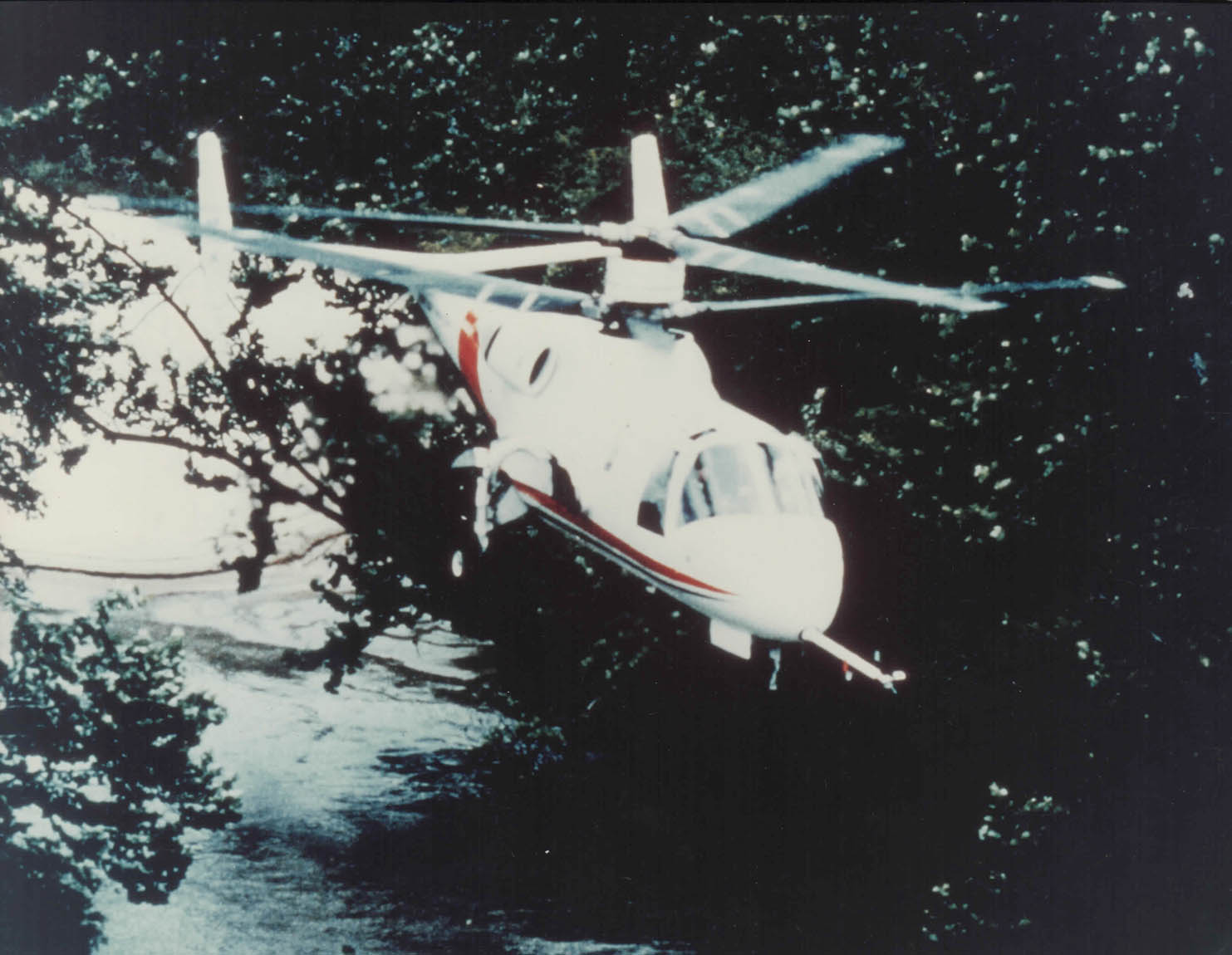
By 1981 the development program was complete. The XH-59A proved the basic advancing blade concept, achieving a level flight speed of 240 knots without the use of a wing, a feat never before accomplished by the helicopter industry. This successful R&D program demonstrated the promised speed and altitude performance. Additionally, with the stiff rotors and lack of a tail rotor, the ABC was thought by pilots to be an improvement over conventional helicopters in low speed flight.
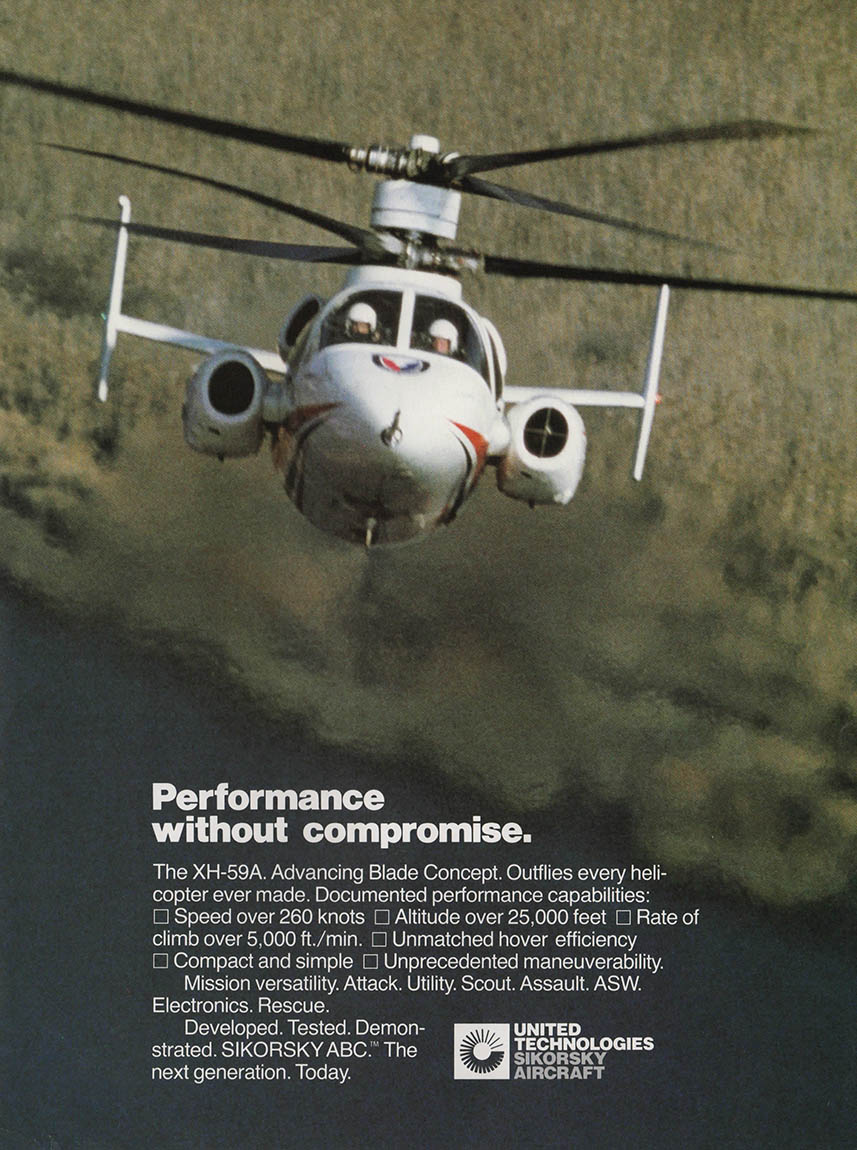
The XH-59A is currently in storage at the U.S. Army Aviation Museum at Ft. Rucker, Alabama
Related Models
Being a concept demonstrator, the XH-59A had a number of compromises in its design to hold program cost down. Primarily among these was the use of separate engines for rotor power and auxiliary propulsion. In a more developed design, a single propulsion system would power both the rotor and an auxiliary propulsion propeller or ducted fan. A high cost item at the time was the monolithic titanium blade spars. Composite materials technology would soon appear which could produce a better blade, with almost infinite options in geometry, at a substantially reduced cost and lighter weight.
Rotor vibration characteristics were acknowledged at the end of the test program as being too high for a production vehicle. Design studies showed that four-bladed rotors would dramatically reduce the rotors’ vibratory characteristics. Also at that time higher harmonic control was receiving a lot of attention throughout the industry, and the thought was that the ABC might benefit from that technology.
To overcome these shortcomings, in 1982 Sikorsky submitted an unsolicited proposal to the Army for extensive modification of the aircraft into the XH-59B configuration. This had the integrated propulsion system with twin General Electric T700-GE-700 engines driving both the rotor system and a ducted pusher propeller. A composite rotor system, with flexbeams replacing the pitch bearings, would replace the heavy titanium blades on the “A” version. A trade-off study was proposed on the question of three versus four-bladed rotors. The 6.5 ft. ducted propeller would be mounted under the rotor system to minimize aircraft size.
The XH-59B program was not funded. Both Sikorsky and the Army had higher priorities at the time.
Sikorsky did many conceptual designs of aircraft using the ABC principle. It was one of a number of concepts initially considered for the UTTAS (later Black Hawk). It had the disadvantage of a tall rotor system which was incompatible with the Army’s requirement that the UTTAS be air transportable in the C-130/141. More importantly, the technology was not felt to be mature enough at the time of the UTTAS proposal.
Thirty years later, with advances in the available technologies in the areas of blade construction, shape and airfoil design, vibration control, propulsion system integration, advanced composite material application and fly-by-wire-control system design, Sikorsky went back to the ABC concept in the development on the X-2 high speed aircraft. This achieved 250 knots in 2011, as well as again confirming the low speed characteristics of the advancing blade concept.
The X2 won the 2010 Collier Award for “demonstrating a revolutionary 250 knot helicopter, which marks a proven departure point for the future development of helicopters by greatly increasing their speed, maneuverability and utility.” The Collier Award is given out once each year for “the greatest achievement in aeronautics or astronautics in America, with respect to improving the performance. efficiency, and safety of air or space vehicles, the value of which has been thoroughly demonstrated by actual use during the preceding year.”
Additional Information Sources
American Helicopter Society paper Fifty Years of Sikorsky High Speed Concepts, Arthur W. Linden. Presented at the 64th AHS Annual Forum, Montreal, Canada, April 29 – May 1, 2008.
Military Potential of the ABC, George Price, American Helicopter Society Vertiflight magazine, November/December, 1982.
American Helicopter Society paper An ABC Status Report, Arthur W. Linden and Andrew J. Ruddell. Presented at the 37th AHS Annual Forum, New Orleans, LA, May, 1981
Naval Air Test Center Technical Report, RW-37R-79, Final report, Advanced Helicopter Rotor Systems, Initial Navy Evaluation of the XH-59A Advancing Blade Concept (ABC) Demonstrator Aircraft, LT. T.L.MacDonald, USN; MAJ M.S.Blair, USMC; and S. Kolwey, January 17, 1980.
The following reference has great detail of information on the full ABC program, including manufacturing technology used, aircraft description, and ground and flight test results:
American Helicopter Society paper The ABC Rotor – A Historical Perspective, Robert K. Burgess. Presented at the 60th AHS Annual Forum, Baltimore, MD, June, 2004
- by Art Linden
Related Articles
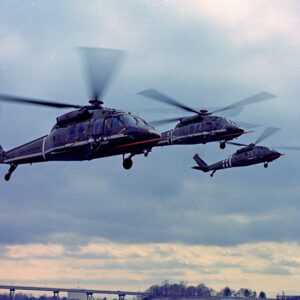
Bill Paul: Reflections on Sikorsky’s 100th Anniversary
Former Sikorsky President Bill Paul reflects on his career with Sikorsky, meeting Igor Sikorsky, and the Sikorsky Aircraft Company’s 100th anniversary.
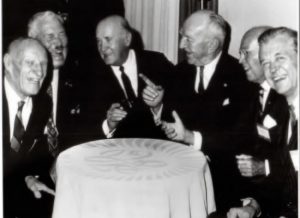
Predictions of a Pioneer
Igor Sikorsky’s predictions for air travel in general and for helicopters in particular have been largely realized or surpassed.
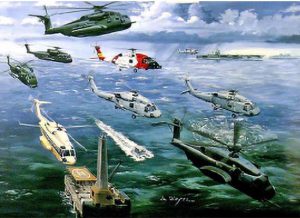
Sikorsky Aircraft Paintings by Andy Whyte
This issue of the newsletter is devoted to the aircraft designs and paintings by Andy Whyte, who had a 40 year career at Sikorsky Aircraft.
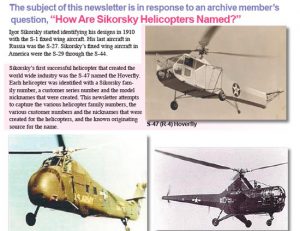
How Sikorsky Helicopters Are Named
The subject of this newsletter is in response to an archive member’s question, “How Are Sikorsky Helicopters Named?”

Sikorsky Aircraft in the 1980s
Business optimism reigned supreme at Sikorsky Aircraft during the 1980s decade.
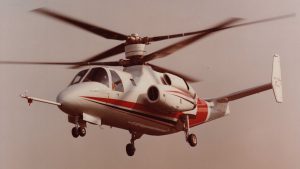
ABC: The High Speed Helicopter
Sikorsky Aircraft created the Advancing Blade Concept during the 1970s with the goal of significantly increasing helicopter flight speed.

